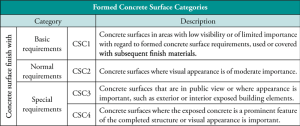ACI has published three documents that will assist in selecting, designing, and specifying formwork systems for concrete structures. The first of these releases was a new document intended to provide a means of better communicating the desired formed surface finish and quality between the engineer/architect and the contractor. The most recent releases are revisions of documents that have been staples in the formwork community for years.
ACI 347.3R-13, Guide to Formed Concrete Surfaces, is an entirely new document released in spring 2014 by ACI Committee 347, Formwork for Concrete. Chapters within ACI 347.3R describe formed surfaces, basics of layout and design, specification, construction, and evaluation of formed surfaces.
The document’s primary function is to provide a detailed method for classifying formed concrete surfaces. Four levels of quality, called Concrete Surface Categories (CSC), are classified based on the visibility of the completed surface as well as the importance of its visual appearance (see Table). For each CSC, qualities such as texture, surface void ratio, color uniformity, surface irregularities, and treatments of construction joints are defined. The guide also discusses phases of construction relating to concrete surfaces, from planning, selection of materials, and construction and repair procedures through the acceptance of a concrete surface. Ultimately, ACI 347.3R-13 can help the project owner, design team, contractor, formwork supplier, concrete supplier, and all other parties involved in the construction process in reaching a specific understanding of how a desired as-cast concrete surface can be defined and produced.
ACI 347R-14, Guide to Formwork for Concrete, presents the recommendations of ACI Committee 347, based on changes that have accumulated in the 10 years since the previous edition was published in 2004. By providing guidance regarding contract documents, selection of formwork, and use of formwork, the document serves as a reference for design architects and engineers, formwork engineers, and contractors.
For easy reference, the document lists items that should be indicated in the contract documents by the engineer/architect. Examples include materials and accessories; finishes; design, inspection, and approval responsibilities; and any requirements that would restrict the selection, design, or layout of the formwork. ACI 347R-14 also contains recommendations for the formwork engineer that will design the formwork and select the components. The recommendations cover topics such as loads, factors of safety, and shoring and bracing. The design recommendations for concrete lateral pressure have been revised to a tabular presentation for a more direct understanding, and the provisions for wind load magnitudes and minimums have been clarified. The chapter on materials has been revised to reflect the changes in many material design specifications and standards used in formwork.
Additional information that can be helpful for all parties includes chapters on architectural concrete, special structures, and special construction methods. These have been generally revised to reflect current practice.
ACI SP-4 Formwork for Concrete, 8th edition, was released in October, 2014. Formwork for Concrete has been and continues to be a cooperative effort supported by individuals, companies, public agencies, and industry and professional associations. In large measure, this is due to the groundwork laid and respect for Formwork for Concrete garnered through the pioneering efforts of the late Mary K. Hurd, the previous author of SP-4.
As a member and past Chair of ACI Committee 347, the author was tasked to revise and update for the new edition. The eighth edition, as all previous editions, follows the most recent guidelines established by ACI Committee 347 and documented in the committee report, now ACI 347R-14, which is reprinted in full in the appendix. This new edition of Formwork for Concrete considers the updated lateral pressure and other provisions now provided by ACI 347R. Expanded coverage is provided in SP-4 for wind loads on formwork specialized from ASCE/SEI 7-10 as modified by ASCE/SEI 37-14. Analysis of the shoring and reshoring process for multi-story buildings, and evaluation of concrete and structure strength to withstand shoring loads, has been expanded in a new chapter. Design of formwork has been divided into two chapters, one focusing on bending, shear, and deflection of wall, slab, and column formwork members, and a second focusing on shoring and bracing members. Bridge formwork considerations have been moved into a separate chapter. A new chapter summarizing the recommendations of ACI 347.3R on specifying and evaluating formed concrete surfaces has been added.
This edition also reflects changes in wood design recommendations of the AWC NDS-2012 with 2013 addendum, and introduces load and resistance factor design (LRFD) for wood formwork members in addition to the primary coverage based on allowable stress design (ASD) procedures. The recent recommendations of other ACI committees have also been considered in the manual revisions and some related OSHA provisions have been extracted for convenient reference in the appendix. The extensive glossary of terms has been updated to reflect the latest changes in ACI 347R and ACI Concrete Terminology.
Revising and bringing an iconic document up-to-date included reference to the latest design standards, design methods, procedures, products, and both revised and new worked examples. Nearly 500 modern color photographs were selected to enable the eighth edition of Formwork for Concrete to be the first edition in full color.▪

